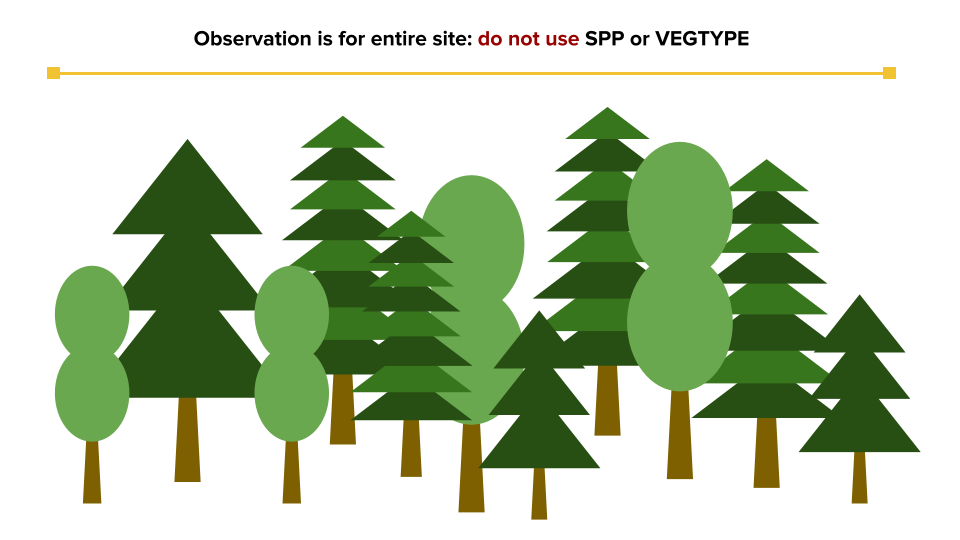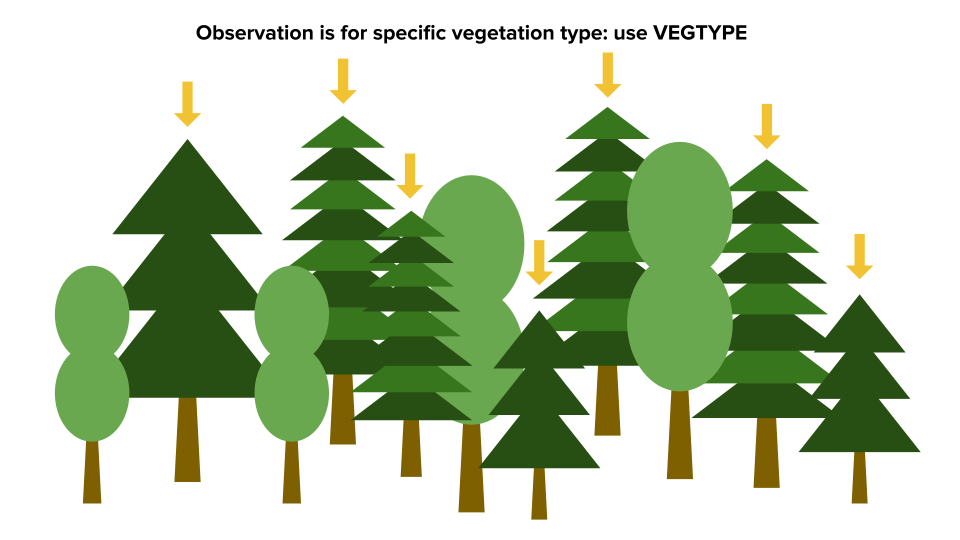BADM Group Overview
BADM variables in this group are organized as shown below. The overview highlights what variables are required per group. It also indicates which variables cannot be specified together ( OR ) in the same group entry. See BADM Basics for more details.
Multiple entries of this BADM group can be reported per site. However, combinations of Ⓒ variables must be unique. Read more:
Optional Variable
Ⓒ Combinations
Examples
| Required | Optional | ||||||||||||||||||
|---|---|---|---|---|---|---|---|---|---|---|---|---|---|---|---|---|---|---|---|
Leaf Area Index |
|
|
BADM variables: Definitions, Units, Requirements
See Overview tab or BADM Basics for explanation of Required and Optional variables.
Multiple entries of this BADM group can be reported per site. However, combinations of Ⓒ variables must be unique. Read more:
Optional Variable
Ⓒ Combinations
Examples
| Variable Requirements | Units | Description |
|---|---|---|
| LAI Required | m2 m-2 | Vegetation (Plant, Leaf, Green) Area Index Leaf Area Index (or other Vegetation Area Index as indicated in LAI_TYPE) at the tower site. Calculated as one half the total leaf area (the one-sided leaf area) per unit ground surface area. |
| LAI_TYPE Ⓒ Required | LIST(LAI_TYPE) Show | Vegetation (Plant, Leaf, Green) Area Index type Use predefined list to indicate type of Vegetation Area Index. Note that Leaf Area Index is one type of Vegetation Area Index type. See predefined list for definitions. |
| LAI_CANOPY_TYPE Ⓒ Required | LIST(LAI_CANOPY_TYPE) Show | Vegetation (Plant, Leaf, Green) Area Index canopy type Use predefined list to indicate the type of canopy being described by the LAI measurement. Use Total for non-forest ecosystems. For forest ecosystems, use Total if not reporting separate Overstory and Understory LAI measurements. |
| LAI_SPP Ⓒ Optional-a | Scientific name | Vegetation (Plant, Leaf, Green) Area Index species (taxa) Vegetation species being described by the measurement. To enter a plant species, use the scientific name (Genus species Author or Genus Author). Please refer to www.theplantlist.org for current scientific names and authors. If the measurement includes all vegetation present, do not enter a value. Do not use SPP if reporting VEGTYPE. |
| LAI_VEGTYPE Ⓒ Optional-a | LIST(VEGTYPE) Show | Vegetation (Plant, Leaf, Green) Area Index vegetation type Use the predefined list to indicate the type of vegetation being described by the measurement (e.g., Grass, Evergreen Tree, Deciduous Tree, etc). If the measurement includes all vegetation present, do not enter a value. If vegetation type is not in predfined list, enter "Other/Not in list" and describe briefly in Approach. Do not use VEGTYPE if reporting SPP. |
| LAI_STATISTIC Ⓒ Required | LIST(STATISTIC) Show | Vegetation (Plant, Leaf, Green) Area Index statistic The statistic for the measurement reported. Use predefined list (e.g., mean, min / max, standard deviation, etc). |
| LAI_STATISTIC_METHOD Ⓒ Optional | LIST(STATISTIC_METHOD) Show | Vegetation (Plant, Leaf, Green) Area Index statistic method Method used to generate the reported statistic (e.g., aggregate of individuals, aggregate of sample aggregates) from observations representing the same time period. Use predefined list. The aggregation method is not meant to describe temporal aggregations for example in calculations of higher frequency observations (e.g., sub-minute) to lower frequency observations (e.g., hourly) at a single location. |
| LAI_STATISTIC_NUMBER Optional | integer number | Number of observations used to determine Vegetation (Plant, Leaf, Green) Area Index statistic Number of observations (samples / replicates) used to calculate the STATISTIC for the reported measurement. |
| LAI_CLUMP Optional | decimal number | Foilage element clumping index for Vegetation (Plant, Leaf, Green) Area Index measurement Foliage element clumping index is used to correct optical data estimates of LAI. Use this variable only if the method specified in LAI_METHOD supports clumping correction. For conifers, use needle clumping within shoot. |
| LAI_METHOD Ⓒ Optional | LIST(LAI_METHOD) Show | Vegetation (Plant, Leaf, Green) Area Index methodology Method used to quantify the Vegetation (Plant, Leaf, Green) Area Index. Use predefined list. If method is not present, select "Other" and give additional details in LAI_APPROACH. |
| LAI_APPROACH Optional | free text | Vegetation (Plant, Leaf, Green) Area Index measurement approach Report additional details used to quanity Vegetation (Plant, Leaf, Green) Area Index. |
| LAI_DATE Ⓒ Required-b | YYYYMMDDHHMM | Vegetation (Plant, Leaf, Green) Area Index measurement date Please report the date at the precision known. Allowed reporting precisions are YYYY, YYYYMM, YYYYMMDD, and YYYYMMDDHHMM. For measurements conducted during a campaign or for temporal averages, use DATE_START and DATE_END instead of DATE. |
| LAI_DATE_START Ⓒ Required-b | YYYYMMDDHHMM | Start date of Vegetation (Plant, Leaf, Green) Area Index measurment Start date of a measurement campaign or start date of a temporal average. Please report the date at the precision known. Allowed reporting precisions are YYYY, YYYYMM, YYYYMMDD, and YYYYMMDDHHMM. Do not use DATE_START if DATE is used. |
| LAI_DATE_END Required | YYYYMMDDHHMM | End date of Vegetation (Plant, Leaf, Green) Area Index measurment End date of a measurement campaign or end date of a temporal average. Please report the date at the precision known. Allowed reporting precisions are YYYY, YYYYMM, YYYYMMDD, and YYYYMMDDHHMM. Do not use DATE_END if DATE is used. |
| LAI_DATE_UNC Optional | days | Uncertainty in the Vegetation (Plant, Leaf, Green) Area Index measurement date, start date, and/or end date If uncertainty in the start date differs than end date, report the uncertainty for start date here in DATE_UNC and the uncertainty for end date in Comments. |
| LAI_COMMENT Optional | free text | Vegetation (Plant, Leaf, Green) Area Index comments |
BADM Examples
Choose a variable marked with to show examples of how to submit and interpret these BADM. See BADM Basics for more details.
Combinations of Ⓒ variables must be unique. Read more: .
Optional Variable
Ⓒ Combinations
Examples
| Leaf Area Index |
Customize and Download CSV for BADM Submission
After selecting your desired variables, download the customized CSV file for submission of BADM. For additional submission details, see BADM Submission Instructions. See BADM Basics for general BADM details.
Multiple entries of this BADM group can be reported per site. However, combinations of Ⓒ variables must be unique. Read more: . See BADM Basics for more details.
Optional Variable
Ⓒ Combinations
Examples
| Required | Optional | ||||||||||||||||||||
|---|---|---|---|---|---|---|---|---|---|---|---|---|---|---|---|---|---|---|---|---|---|
|
|
Submit completed CSV file at Upload Data using the BADM option (login required).








